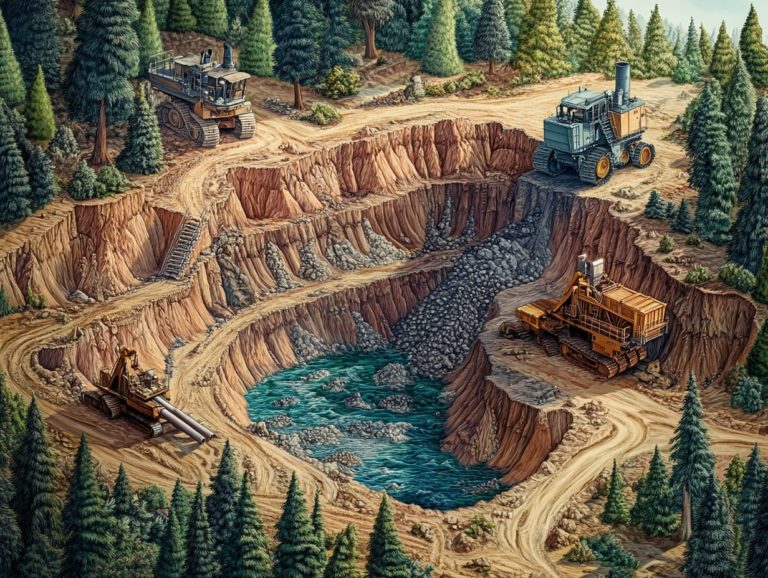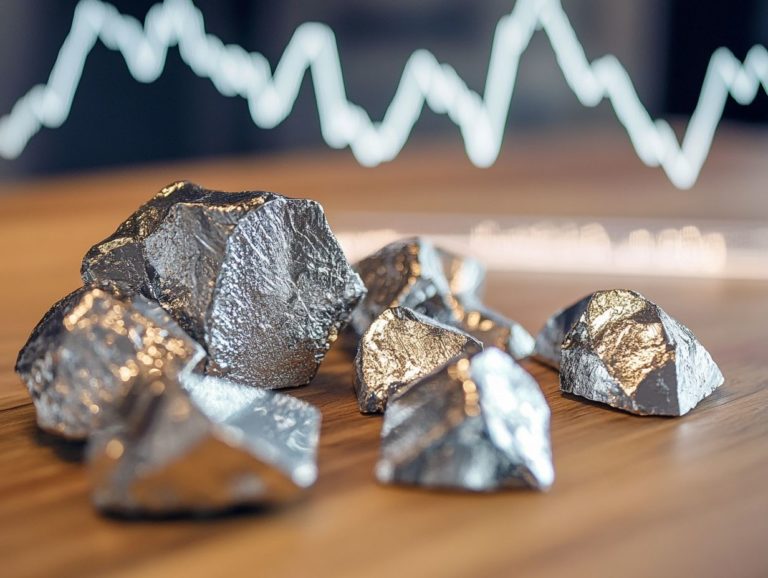The Growing Demand for Palladium Explained
Palladium is a precious metal often overshadowed by gold and silver.
However, it is now gaining remarkable attention in today s market.
Recognized for its unique properties and crucial role across various industries, this metal is steadily increasing in value.
From automotive catalysts to electronics, the applications of palladium are both extensive and essential.
As demand surges, it s crucial for you to understand the factors driving this trend, the challenges surrounding its supply, and the broader economic implications at play.
Discover how palladium can shape your investment choices and why understanding its market dynamics is crucial right now!
Contents
- Key Takeaways:
- The Basics of Palladium
- The Current Demand for Palladium
- The Supply and Availability of Palladium
- The Impact of Palladium on the Economy
- Frequently Asked Questions
- What is palladium and why is the demand for it growing?
- How does the automotive industry impact the demand for palladium?
- Why is palladium favored over other precious metals like gold and platinum?
- Is the growing demand for palladium sustainable?
- How does the price of palladium fluctuate?
- Conclusion
- What are the implications of the growing demand for palladium on the environment?
Key Takeaways:
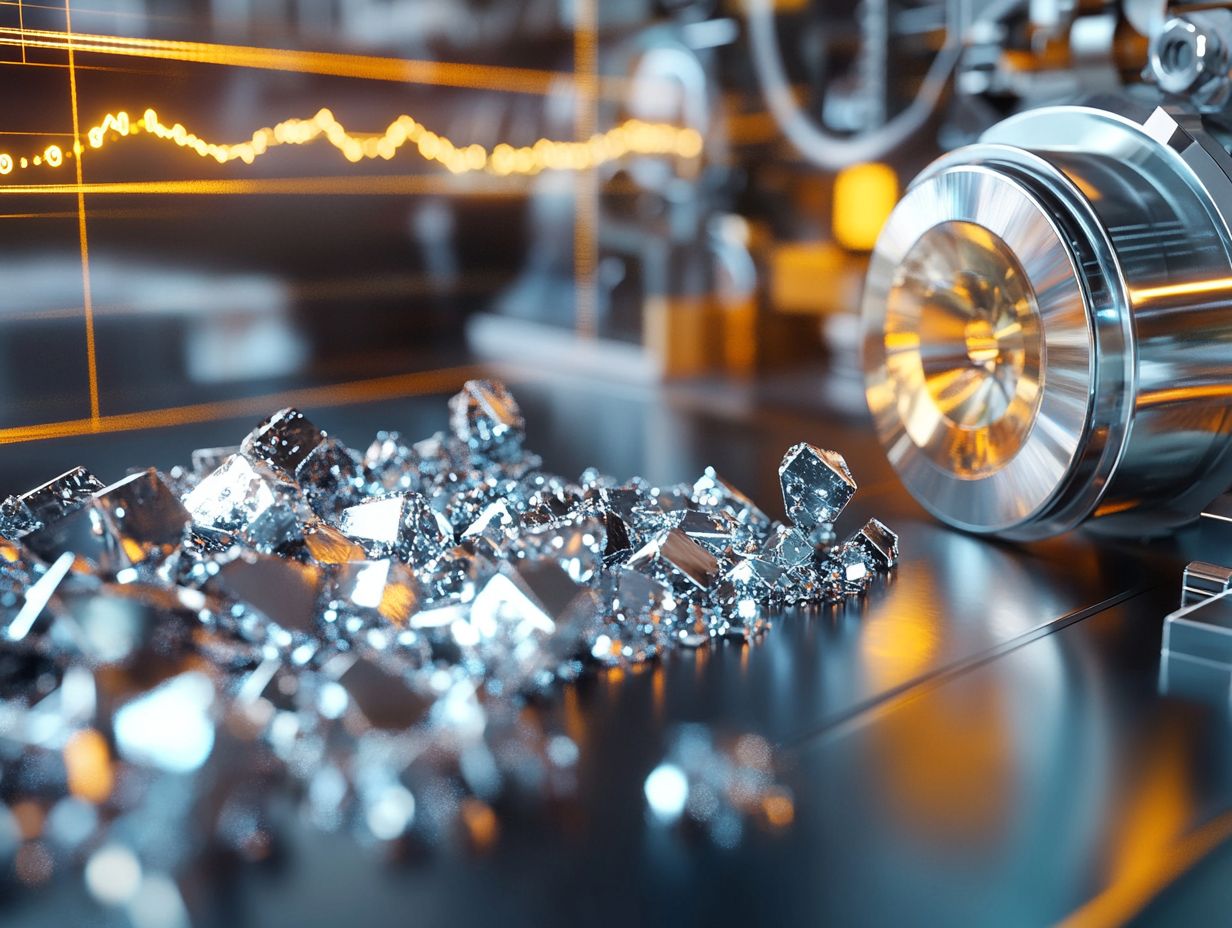
- Palladium is a rare and valuable metal used in various industries, including jewelry, electronics, and automotive manufacturing.
- The growing demand for palladium is driven by factors such as stricter emissions standards, increasing demand for hybrid and electric vehicles, and limited supply.
- The limited primary sources and production challenges have caused fluctuations in palladium supply, leading to an impact on the global economy and creating investment opportunities for those interested in the metal.
The Basics of Palladium
Palladium, a precious metal from the well-known group of metals that includes platinum, has captured significant attention for its vital role in devices in cars that reduce harmful emissions.
As global production of palladium evolves, it s crucial for you to grasp its properties and applications.
This understanding will illuminate its importance in enhancing environmental performance and meeting increasingly stringent emission standards.
What is Palladium?
Palladium is a rare and exquisite precious metal, part of the platinum group metals family, celebrated for its remarkable catalytic properties and resistance to corrosion.
First discovered in 1803 by the British chemist William Hyde Wollaston, it emerged from platinum ore, revealing its potential to the world.
With its stunning silvery-white sheen, palladium is a vital player in catalytic converters, expertly transforming harmful gases from automobile exhaust into less-toxic emissions.
This process is essential for environmental protection, making palladium a key contributor to a cleaner planet.
But its allure doesn’t stop there; the electronics industry values palladium for its exceptional conductivity, while jewelers appreciate its hypoallergenic properties.
As demand in these sectors continues to rise, palladium remains in the spotlight for its unique blend of utility and rarity.
How is it Used?
Palladium finds its way into a multitude of industries, most prominently in catalytic converters in cars, where it plays a crucial role in mitigating harmful emissions.
Its impact doesn t stop at the automotive sector.
In the realm of electronics, this remarkable metal is essential for crafting components like capacitors and connectors, offering outstanding conductivity while resisting corrosion effortlessly.
In the chemical industry, palladium shines as a catalyst in various reactions, significantly boosting efficiency and yield.
Its aesthetic allure also makes it a favorite in jewelry design, often used in white gold alloys and as a standalone metal for crafting intricate pieces.
Palladium s biocompatibility enhances its value in dental restorations, providing durable and resilient options for crowns and other prosthetics.
The Current Demand for Palladium
The current demand for palladium is largely fueled by its crucial role in adhering to stringent emission standards, especially within the automotive industry.
As hybrid vehicles gain traction for their reduced environmental impact, the importance of palladium continues to rise, making it a key player in the ongoing shift toward more sustainable transportation solutions.
Factors Driving Demand

Several factors fuel interest in palladium. Tightening emission standards drive automotive manufacturers to embrace hybrid vehicles.
These standards compel manufacturers to integrate palladium into devices that reduce harmful gases from car exhaust. Catalytic converters are crucial for minimizing harmful emissions.
Advancements in electric vehicle production and battery technology have also heightened the allure of this metal, as automakers strive to enhance fuel efficiency.
Geopolitical tensions contribute significantly; political conflicts between countries that can disrupt supply introduce volatility in availability, thereby impacting market dynamics. The global momentum towards stricter environmental policies further solidifies this trend, positioning palladium as an essential component in the shift towards greener automotive solutions.
Industries and Applications
Palladium finds its way into a multitude of industries, with a standout role in the automotive sector through catalytic converters, alongside significant contributions in electronics, chemical production, and jewelry.
In the automotive realm, palladium is critical for reducing harmful emissions, positioning it as a key player in the pursuit of cleaner air.
In terms of electronics, its excellent conductivity and resistance to corrosion make it a preferred choice for connectors, capacitors, and various components.
The chemical industry also takes advantage of palladium as a catalyst, enhancing efficiency in the production of pharmaceuticals and other important compounds.
Meanwhile, the jewelry sector values palladium for its lustrous finish and hypoallergenic properties, driving demand for this precious metal in upscale pieces.
These diverse applications create a strong demand for palladium that is hard to ignore!
The Supply and Availability of Palladium
The supply and availability of palladium hinge significantly on the primary production sources, notably major mining companies such as Norilsk Nickel, Ivanhoe Mines, and North American Palladium. These industry leaders play a pivotal role in shaping global production levels, thereby influencing the market landscape.
Primary Sources of Palladium
The primary sources of palladium stem from major mining operations carried out by companies like Norilsk Nickel, Ivanhoe Mines, and North American Palladium, all of which are essential for meeting global demand.
These companies engage in a variety of mining projects across diverse geographical regions, each uniquely enhancing overall production capabilities.
For example, Norilsk Nickel primarily operates in Russia, where it holds some of the largest reserves of palladium, providing a significant supply chain advantage.
On the other hand, Ivanhoe Mines is progressing with its projects in the Democratic Republic of Congo, where rich ore bodies promise to boost output.
Meanwhile, North American Palladium, primarily recognized for its Canadian operations, is committed to sustainable practices that enhance production while minimizing environmental impact.
Understanding these supply risks is critical for anyone invested in this vital industry. Together, these key players are driving forces in shaping the future of palladium production!
Challenges in Supply and Production
Challenges in the supply and production of palladium are often intensified by geopolitical factors, which can lead to unexpected disruptions and impact global availability.
These disruptions frequently stem from tensions in key producing regions, where political instability or trade sanctions can abruptly halt operations.
Economic conditions, such as currency fluctuations and rising extraction costs, add further complexity to the situation.
Mining operations also grapple with environmental regulations and labor disputes, leading to project delays and increased expenses.
As a result, these challenges ripple through the market. They can cause wild fluctuations in prices for this vital metal, which is essential for various industrial applications, including catalytic converters in the automotive sector.
The Impact of Palladium on the Economy
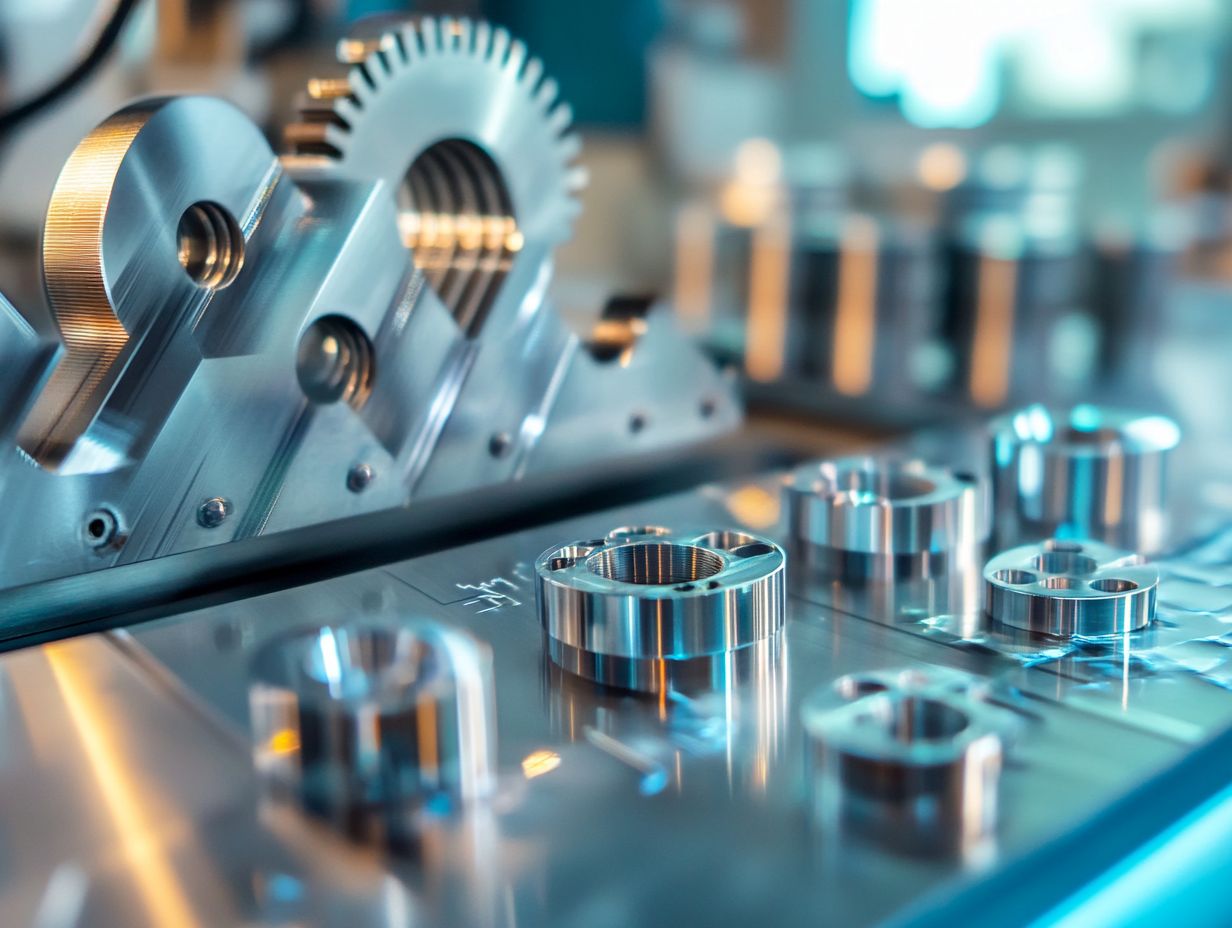
Palladium plays a vital role in shaping the global economy. It influences market dynamics and creates investment opportunities. Its volatile pricing trends and essential applications across various industries make it a key player in today’s economic landscape.
Palladium’s Role in the Global Economy
The global economic impact of palladium is clear. Its influence over investment demand and pricing trends reflects market fluctuations.
As industrial applications especially in the automotive sector continue to drive demand, investors closely monitor shifts in its valuation. Economies heavily reliant on palladium production, like Russia and South Africa, feel the effects of price changes.
This price volatility can lead to strategic shifts in investment portfolios. Traders may turn to palladium during times of political issues or when production yields are affected. The relationship between investment sentiment and palladium s market behavior represents broader economic patterns unfolding globally.
Exciting Investment Opportunities
Exciting investment opportunities in palladium are booming right now, driven by increasing demand and dynamic market forces. With applications ranging from automotive catalytic converters to electronics, this precious metal has a significant presence across various sectors.
A closer look at historical data shows that palladium often outperforms its counterparts, such as gold and silver, during periods of heightened industrial activity. Investors should be aware of risks in availability and geopolitical factors that might influence supply and prices.
Looking ahead, forecasts suggest that as sustainable technologies evolve, the demand for palladium could rise even further. This positions it as a compelling investment avenue for those looking to diversify their portfolios.
Frequently Asked Questions
What is palladium and why is the demand for it growing?
Palladium is a rare and lustrous silvery-white metal primarily used in producing catalytic converters for automobiles. The demand for palladium is growing due to stricter emissions regulations, particularly in China and Europe, which mandate the use of catalytic converters in vehicles.
How does the automotive industry impact the demand for palladium?
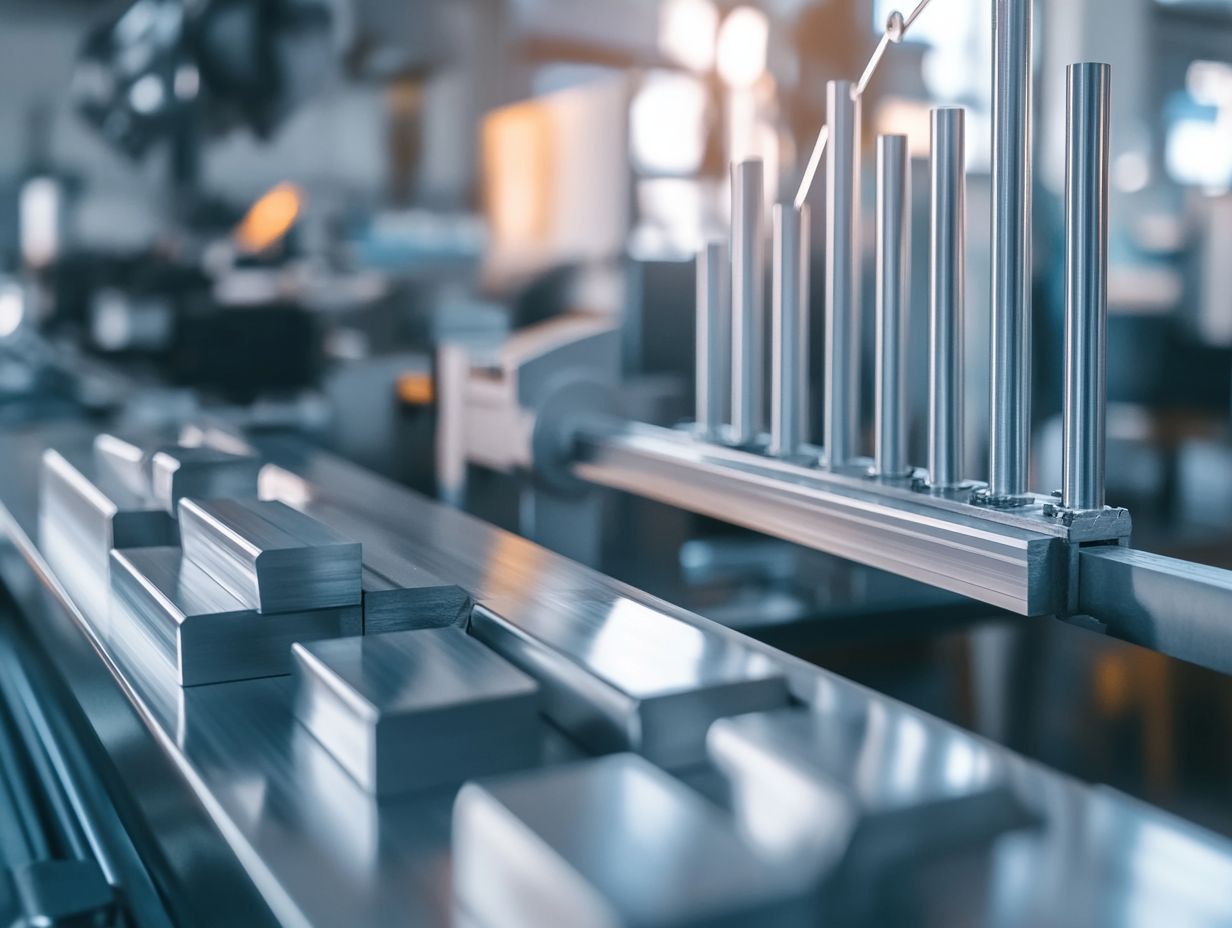
The automotive industry is the main driver of palladium demand. It is estimated that about 85% of global palladium consumption is for catalytic converters used in cars and trucks. As the global demand for vehicles rises, so does the demand for palladium.
Why is palladium favored over other precious metals like gold and platinum?
Palladium is preferred over other precious metals due to its unique properties, especially its capability to effectively reduce harmful emissions from vehicles. It is also less expensive than other precious metals, making it a cost-effective choice for manufacturers.
Is the growing demand for palladium sustainable?
While the demand for palladium is currently increasing, experts believe it may not be sustainable long-term due to limited global supplies. Efforts are underway to develop alternative materials for catalytic converters, but these have not yet gained widespread adoption.
How does the price of palladium fluctuate?
Like other precious metals, palladium prices are influenced by market forces such as supply and demand, economic conditions, and geopolitical events. Recently, palladium prices have been on the rise due to growing demand and limited supply.
Conclusion
Palladium plays a crucial role in the economy, presenting both challenges and exciting investment opportunities. As demand continues to evolve, it’s essential to stay informed and consider exploring investment options in this valuable metal.
What are the implications of the growing demand for palladium on the environment?
Palladium demand is rising. This increase has raised environmental concerns.
Palladium mining can cause air and water pollution. Disposing of used catalytic converters can also harm the environment.
Efforts are underway to enhance recycling methods. There s also a push for more sustainable mining practices.










